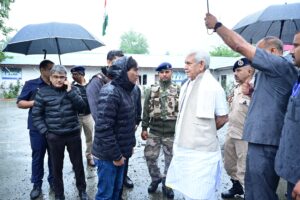Kishtwar: The Untapped Jewel of Jammu and Kashmir
Amidst the lofty mountains high,
Where saffron blooms ‘neath sapphire sky,
Kishtwar’s beauty calls the soul to roam,
A perfect place to feel at home.
With deodar woods and trails so grand,
Adventure waits at every hand.
Its sacred shrines and rivers gleam,
Promote tourism—fulfill the dream!
Tucked away in the Himalayan embrace, Kishtwar is a hidden gem of Jammu and Kashmir, known for its stunning landscapes, rich cultural heritage, and spiritual sanctuaries. From the winding Chenab River to vibrant saffron fields, majestic sapphire mines, and sacred temples, Kishtwar is a land of untapped potential. However, its development, particularly in tourism, lags far behind its natural and cultural offerings.
This comprehensive guide explores the natural beauty, spiritual legacy, and challenges of Kishtwar, with insights into how this jewel can shine brighter on the map of India.
Nature’s Bounty in Kishtwar
* The Chenab River: Lifeline of the Region:
The Chenab River, with its crystal-clear waters, weaves through Kishtwar, nourishing its fertile plains and powering critical hydroelectric projects like Dul Hasti, Ratle, Pakaldul, and Kiru. Despite contributing to energy generation, Kishtwar ironically faces power shortages, highlighting inefficiencies in resource management.
If harnessed effectively, the Chenab’s hydroelectric potential could not only illuminate the district but also drive infrastructure growth, employment, and sustainable development in the region.
* Saffron Fields and Sapphire Mines:
Kishtwar’s saffron fields are a canvas of vibrant hues and a source of cultural and economic pride. Meanwhile, its rugged mountains hide rare sapphire deposits, yet to be fully explored and utilized. These treasures present immense potential to boost the local economy through careful and sustainable development.
Sacred Sites and Spiritual Significance:
* Mata Sarthal Devi Temple:
Located in the tranquil Sarthal Valley, this temple is dedicated to Mata Sarthal Devi, believed to be an incarnation of Maa Durga. The temple’s serene setting, at an altitude of 7,000 feet, offers breathtaking views of the surrounding valleys.
The Legend of Mata Sarthal Devi
– Divine Protector: Mata Sarthal Devi is revered as the protector of the weak and a symbol of feminine energy.
– A Shepherd’s Vision: Local lore tells of a shepherd discovering a self-manifested (swayambhu) idol of the goddess in the forest, leading to the establishment of the temple.
– Annual Yatra The Sarthal Devi Yatra, held in June or July, attracts thousands of devotees for rituals, prayers, and cultural celebrations.
* Mata Machail Temple:
Nestled in the scenic Paddar Valley, the Mata Machail Temple is another revered shrine, dedicated to Goddess Chandi. The annual Machail Mata Yatra draws pilgrims from across the country, offering a spiritual journey through the untouched beauty of the Himalayas.
* Ziyarat Hazrat Shah Asrar-ud-Din Sahib (RA):
This Sufi shrine, dedicated to Hazrat Shah Asrar-ud-Din Sahib, is a testament to Kishtwar’s spiritual diversity. Its architectural beauty and tranquil ambiance make it a haven for spiritual seekers.
Tourist Attractions in Kishtwar
* Putinag and Naginsheer:
These picturesque regions boast lush meadows, snow-capped peaks, and serene streams. Introducing Gondola rides here could revolutionize tourism, offering aerial views of the breathtaking landscapes while creating local employment opportunities.
* Sinthon Top:
A high-altitude mountain pass connecting Kishtwar with Srinagar, Sinthon Top is ideal for adventure tourism, including trekking, skiing, and paragliding. Hosting snow festivals and adventure events could further attract global tourists.
* Bimalnaag and Trisandhiya Temples:
– The Bimalnaag Temple in Saroor and the Trisandhiya Temple in Dacchan Valley combine natural beauty with spiritual significance.
– The Trisandhiya Temple is particularly famous for a miraculous flame that appears three times daily, drawing spiritual seekers and curious travelers alike.
* Choughan Ground:
At the heart of Kishtwar, the Choughan Ground serves as a cultural and communal hub, hosting festivals, sports, and local events. It reflects the district’s harmony and vibrant community spirit.
Promoting Sports: Need for a Stadium
Sports play a vital role in youth development and community building. However, Kishtwar lacks proper sports facilities, limiting opportunities for local talent. Establishing a well-equipped stadium with facilities for cricket, football, athletics, and indoor games is essential.
A stadium can serve as a venue for sports events, encourage physical fitness, and provide a platform for local athletes to showcase their talents. Additionally, promoting sports can engage the youth positively, reducing unemployment and fostering a sense of discipline and teamwork.
Skill Development: Empowering the Youth
Skill development is crucial for creating a self-reliant and prosperous community. Many young people in Kishtwar lack access to proper vocational training, limiting their job prospects. Setting up skill development centers offering training in various fields like tourism, hospitality, agriculture, handloom, and handicrafts can open new avenues for employment.
Programs under the government’s Skill India Mission and schemes like Tejaswini can be leveraged to train the youth in modern skills, making them industry-ready. Additionally, providing financial assistance and market linkages can encourage entrepreneurship, boosting the local economy.
Preserving Traditions: Grass Artistry of Nagseni
In the remote Nagseni region, artisans craft eco-friendly chapel phuler (grass footwear) and chakla (sitting mats) using local grasses. These handmade items are both sustainable and culturally significant.
Promoting these crafts through eco-tourism and exhibitions could provide livelihood opportunities for artisans while preserving a centuries-old tradition. Supporting this green legacy aligns with global movements toward sustainability.
Inspiring Figures: Sheetal Devi
Kishtwar takes pride in Sheetal Devi, a world-class para-archer who has overcome immense challenges to achieve international success. Her story is a beacon of hope and inspiration for the youth, embodying resilience and excellence.
Challenges and Solutions
One of the major challenges in Kishtwar is inadequate infrastructure, particularly in terms of road connectivity. The district relies on a single road, which often faces heavy traffic congestion due to ongoing construction projects and the movement of dumpers. Constructing a bypass road is essential to ease traffic flow and improve safety.
Additionally, developing accommodations and transport facilities is crucial to support tourism. Building eco-friendly resorts and homestays can provide comfortable lodging for tourists while preserving the natural environment.
• Proposed Steps for Development:
1. Enhance Road and Transport Infrastructure: Build a bypass road and improve existing road networks for better connectivity.
2. Promote Sustainable Tourism: Develop eco-friendly accommodations, introduce guided treks, and host adventure sports events.
3. Develop Market Linkages: Create better market access for saffron, sapphires, and handmade crafts through online platforms and trade fairs.
4. Organize Festivals and Cultural Events: Promote regional festivals to attract tourists and investors while preserving cultural heritage.
5. Improve Healthcare Facilities: Establish better healthcare infrastructure and introduce air connectivity to ensure timely medical assistance for critically ill patients.
6. Build a Sports Stadium: Establish a well-equipped stadium to promote sports and nurture young talent.
7. Set Up Skill Development Centers: Provide vocational training to empower the youth and encourage entrepreneurship.
Dr. Daisy Parihar






